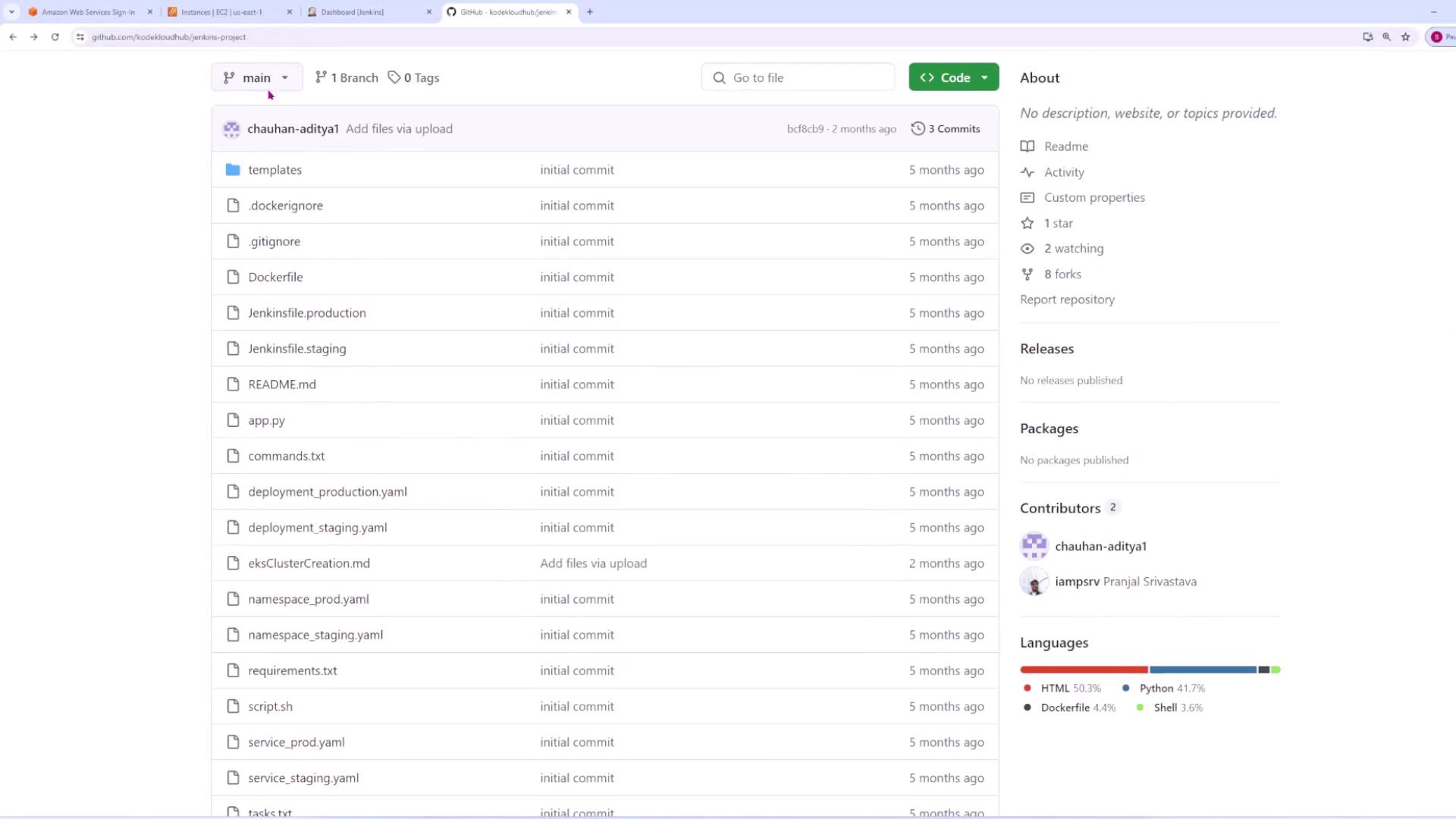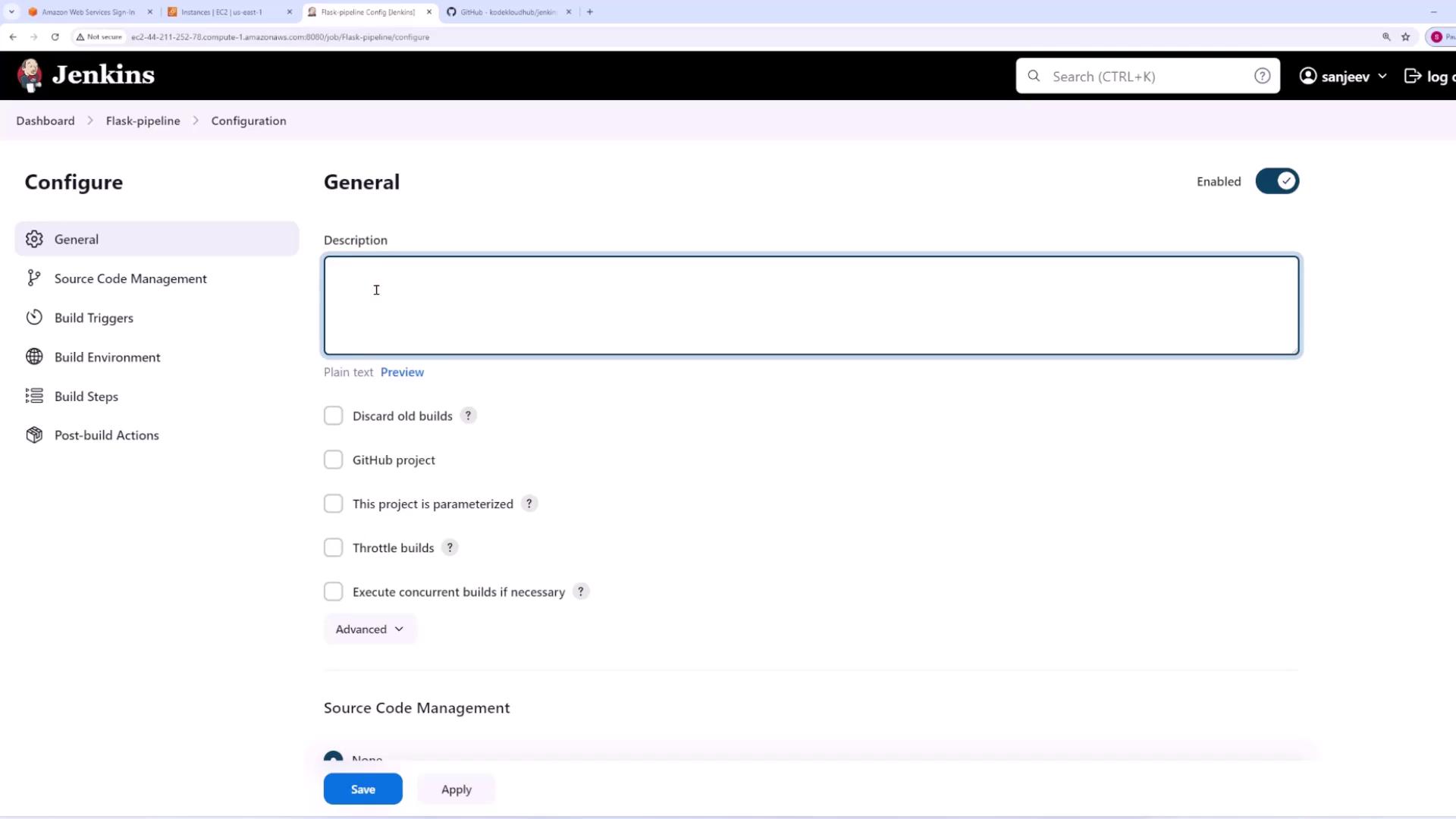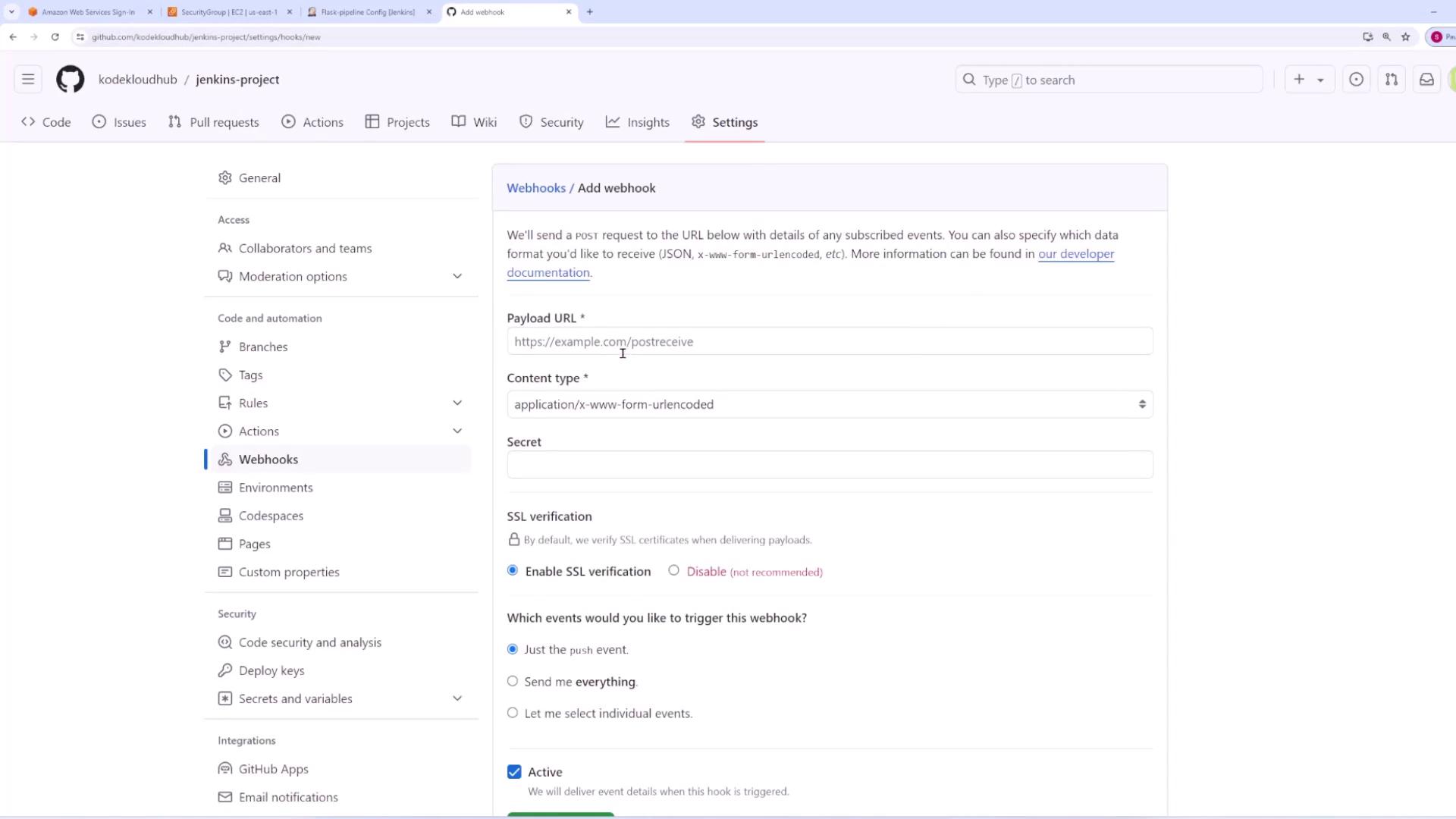Jenkins Project: Building CI/CD Pipeline for Scalable Web Applications
Jenkins
Integrating with Git
In this lesson, we demonstrate how to integrate Git with Jenkins using a simple Flask application. The goal is to trigger builds automatically whenever changes are pushed to the Git repository.
Step 1. Start with Your Flask Application
Begin with a Flask application hosted in a Git repository.

Step 2. Configure Jenkins to Trigger Builds
Create a New Jenkins Job
- From the Jenkins dashboard, click on "New Item" and name the job "Flask pipeline."
- Select the Freestyle project option to build a basic pipeline and click OK.

Configure Job Details
- You can add an optional project description on the next screen to provide context for your team.

Set Up Source Code Management
- In the Source Code Management section, change the default "None" option to Git.
- Enter the Git repository URL. For public repositories, credentials are not necessary; for private repositories, configure the appropriate credentials.

Specify the Branch to Build
- By default, Jenkins may reference the
/masterbranch. If your repository uses a branch namedmain, update the branch information accordingly. - Leaving the branch field blank triggers builds for any branch; however, the focus here is on the
mainbranch.

Configure Build Triggers
- Scroll down to the Build Triggers section and select GitHub hook trigger for Git SCM polling. This enables GitHub to send a webhook notification to the Jenkins server whenever changes are pushed.
Add Build Steps
Add a build step by selecting Execute Shell.
In the command text box, include the following command to output a test message during the build process:
echo "Hello from Jenkins"
Step 3. Set Up GitHub Webhook
Configure GitHub to notify Jenkins when changes occur:
- Navigate to your GitHub repository’s Settings, then access the Webhooks section.
- Click Add webhook and complete the following:
- Set the Payload URL to your Jenkins server’s URL (for example, using your EC2 instance's public DNS or IP address). Append
/GitHub-webhooksif required. - Choose
application/jsonas the Content Type. - Select Push events to trigger the webhook on code commits.
- Set the Payload URL to your Jenkins server’s URL (for example, using your EC2 instance's public DNS or IP address). Append


Webhook Verification
After configuring, verify that GitHub shows a green checkmark next to your webhook. This confirms that notifications are delivered successfully.
Return to the Jenkins job configuration, click Apply and then Save.
Step 4. Run a Manual Build
Perform a manual build in Jenkins to establish the job configuration. During the first build, Jenkins will clone the repository and execute the shell command.
Sample Console Output
Started by user sanjeev
Running as SYSTEM
Building in workspace /var/lib/jenkins/workspace/Flask-pipeline
The recommended git tool is: NONE
No credentials specified
Cloning the remote Git repository
Cloning repository https://github.com/kodeloudhub/jenkins-project
/usr/bin/git init /var/lib/jenkins/workspace/Flask-pipeline # timeout=10
Fetching upstream changes from https://github.com/kodeloudhub/jenkins-project
> git --version # timeout=10
> git config remote.origin.url https://github.com/kodeloudhub/jenkins-project # timeout=10
> git fetch --tags --force --progress https://github.com/kodeloudhub/jenkins-project +refs/heads/*:refs/remotes/origin/* # timeout=10
> /usr/bin/git rev-parse refs/remotes/origin/main^{commit} # timeout=10
Checking out Revision bfc8c9b987f71911d5c844b1875beeda9 (refs/remotes/origin/main)
> /usr/bin/git config core.sparsecheckout # timeout=10
> /usr/bin/git checkout -f bfc8c9b987f71911d5c844b1875beeda9 # timeout=10
Commit message: "Add files via upload"
First time build. Skipping changelog.
[Flask-pipeline] $ /bin/sh -xe /tmp/jenkins36311316873210734.sh
+ echo 'Hello from Jenkins'
Hello from Jenkins
Finished: SUCCESS
Step 5. Test Auto-Trigger by Pushing Changes
Modify your Flask application (for example, update index.html):
<html>
<head>
<style>
.task-item {
}
.task-text {
margin: 0;
}
</style>
</head>
<body>
<h1>Todo App</h1>
<!-- Add Task Form -->
<form method="post">
After saving your changes, add, commit, and push them using the following commands:
# Add changes to staging
git add
# Commit the changes with a descriptive message
git commit -m "made changes to index.html"
# Push changes to the main branch
git push origin main
Once the changes are pushed, Jenkins will automatically trigger a new build for the "Flask pipeline" job.
Sample Console Output for the Auto-Triggered Build
Started by GitHub push by sanjeevkt720
Running as SYSTEM
Building in workspace /var/lib/jenkins/workspace/Flask-pipeline
The recommended git tool is: NONE
No credentials specified
> /usr/bin/git rev-parse --resolve-git-dir /var/lib/jenkins/workspace/Flask-pipeline/.git # timeout=10
Fetching changes from the remote Git repository
> /usr/bin/git config remote.origin.url https://github.com/kodeloudhub/jenkins-project # timeout=10
Fetching upstream changes from https://github.com/kodeloudhub/jenkins-project
> /usr/bin/git --version # timeout=10
> git --version # git version 2.40.1
> /usr/bin/git fetch --tags --force --progress https://github.com/kodeloudhub/jenkins-project +refs/heads/*:refs/remotes/origin/* # timeout=10
Checking out Revision 335e2031e167245b217bec9a5402a1c94ec5 (refs/remotes/origin/main)
> /usr/bin/git config core.sparsecheckout # timeout=10
> /usr/bin/git checkout -f 335e2031e167245b217bec9a5402a1c94ec5 # timeout=10
Commit message: "made changes to index.html"
> /usr/bin/git rev-list --no-walk bfc8489d5b1161bb14f565b0bea9e7d9 # timeout=10
[Flask-pipeline] $ /bin/sh -xe /tmp/jenkins34718612456724851020.sh
+ echo 'Hello from Jenkins'
Hello from Jenkins
Finished: SUCCESS
Success Verification
After each build (manual or auto-triggered), review the console output in Jenkins. This ensures that the repository is cloned correctly and the build steps, including the execution of the shell command, are completed successfully.
Now, every time changes are pushed to the main branch of your repository, Jenkins will automatically trigger a build using the GitHub webhook integration. For more information on Git and Jenkins integration, check out the Jenkins Documentation and GitHub Docs.
Watch Video
Watch video content
Practice Lab
Practice lab